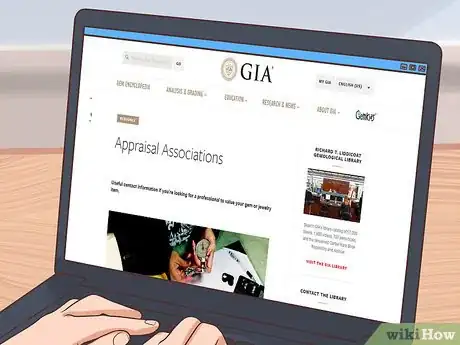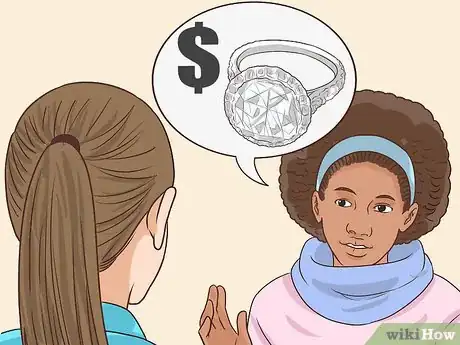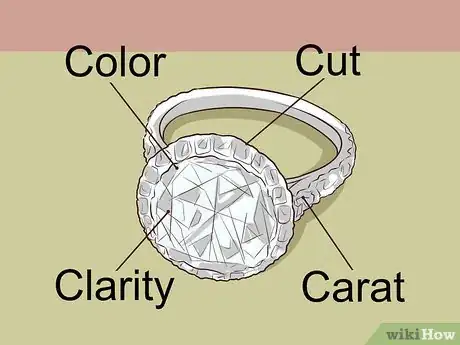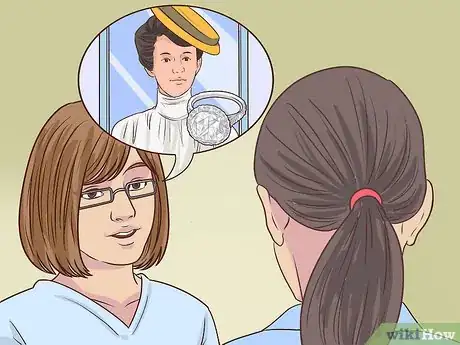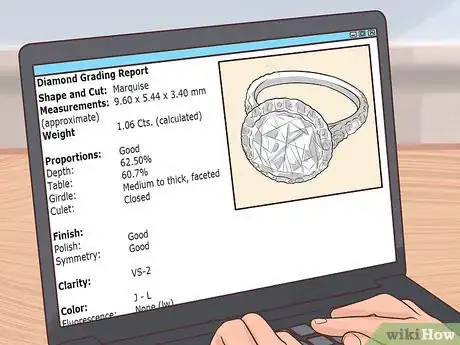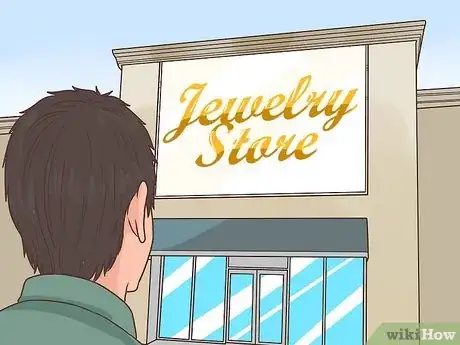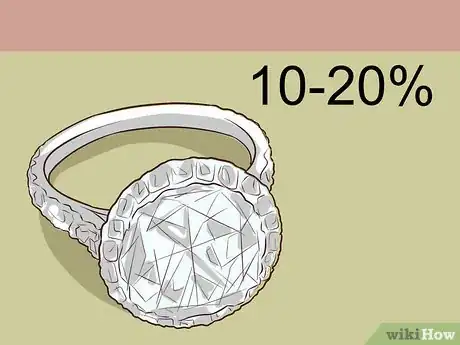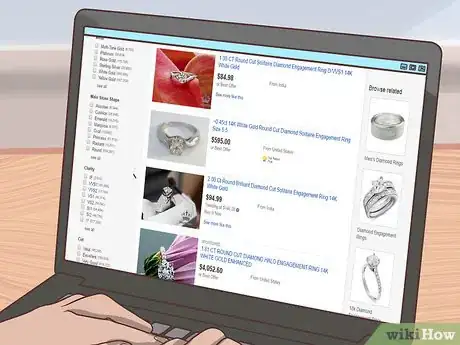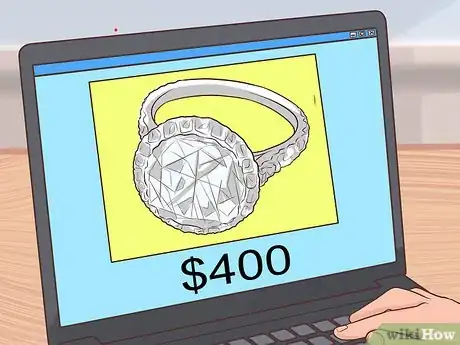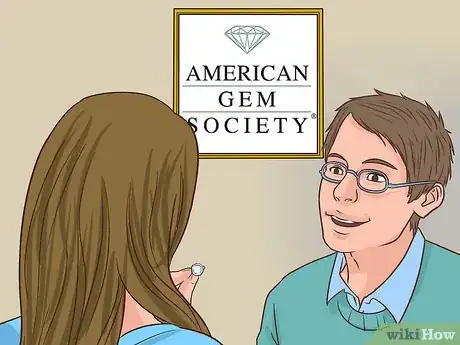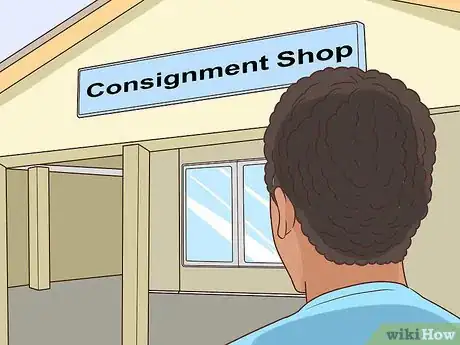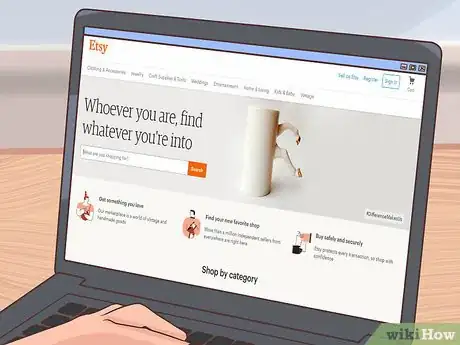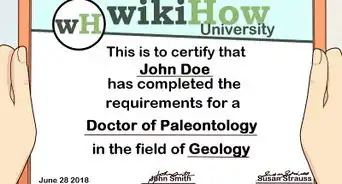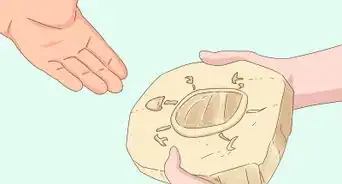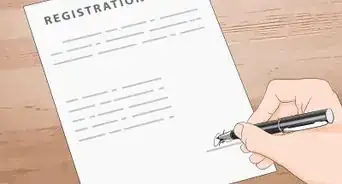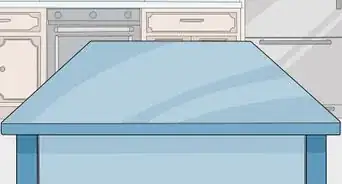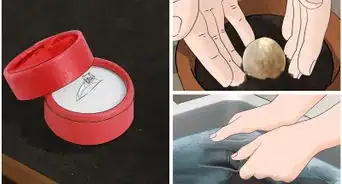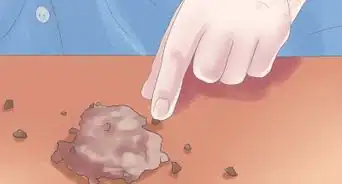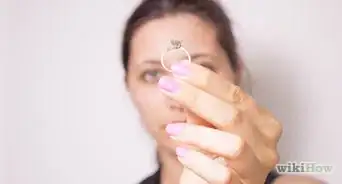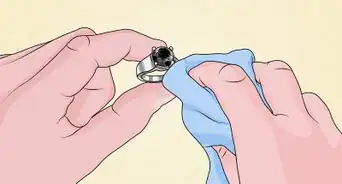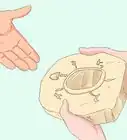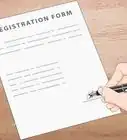This article was co-authored by Jerry Ehrenwald and by wikiHow staff writer, Megaera Lorenz, PhD. Jerry Ehrenwald, GG, ASA, is a graduate gemologist in New York City. He is the previous President of the International Gemological Institute and the inventor of U.S.-patented Laserscribe℠, a means of laser inscribing onto a diamond a unique indicia, such as a DIN (Diamond Identification Number). He is a senior member of the American Society of Appraisers (ASA) and is a member of the Twenty-Four Karat Club of the City of New York, a social club limited to 200 of the most accomplished individuals in the jewelry business.
There are 9 references cited in this article, which can be found at the bottom of the page.
wikiHow marks an article as reader-approved once it receives enough positive feedback. In this case, 93% of readers who voted found the article helpful, earning it our reader-approved status.
This article has been viewed 55,966 times.
Selling your diamond jewelry is a good way to earn a little extra cash, but it can be a daunting process. If you want to get the best price for your diamonds, it is important to understand your options before selling. You can get the most out of the selling experience by getting your diamonds appraised, deciding on a good price, and choosing the right kind of buyer.
Steps
Appraising Your Diamonds
-
1Find a qualified appraiser. Getting a professional appraisal is especially important if you suspect that your diamond jewelry is worth $2000 or more.[1] Most professional appraisers belong to an appraisal association, and these associations can help you find certified appraisers in your area. You can find a list of appraisal associations that specialize in gemstones here: https://www.gia.edu/library-appraisal-associations
-
2Tell the appraiser you want to sell your diamonds. There are different reasons to get jewelry appraised. If the appraiser understands that your goal is to sell your jewelry (rather than, say, to get it insured), then they will be able to give you a more realistic idea of your jewelry's resale value.[2]Advertisement
-
3Get as much information as possible about your diamonds. You will be in a better position to get the best price for your diamonds if you can give potential buyers plenty of information about them. In addition to asking your appraiser for the resale value of the diamonds, try to find out about the following factors, which can affect the value and desirability of a diamond:[3]
- Color: The Gemological Institute of America rates diamonds on a color scale from D (most colorless) to Z (highest color). In general, the more colorless the diamond, the higher its value (with the exception of “fancy color diamonds,” such as pink and blue diamonds).[4]
- Cut: This refers to the shape of the diamond and the quality of the cut.
- Clarity: This is a measurement of the flawlessness of the stone. The Gemological Institute of America rates diamonds from “Flawless” (no inclusions or imperfections) to I3 (the highest level of “Included”).[5]
- Carat: This is a measure of the weight of a diamond.
EXPERT TIPJerry Ehrenwald, GG, ASA, is a graduate gemologist in New York City. He is the previous President of the International Gemological Institute and the inventor of U.S.-patented Laserscribe℠, a means of laser inscribing onto a diamond a unique indicia, such as a DIN (Diamond Identification Number). He is a senior member of the American Society of Appraisers (ASA) and is a member of the Twenty-Four Karat Club of the City of New York, a social club limited to 200 of the most accomplished individuals in the jewelry business.Former President, International Gemological Institute & Graduate Gemologist
 Jerry Ehrenwald
Jerry Ehrenwald
Former President, International Gemological Institute & Graduate GemologistOur Expert Agrees: Jerry Ehrenwald, president of the International Gemological Institute, recommends having your diamond professionally evaluated by an independent gemological laboratory for an accurate and objective appraisal. A gemological laboratory will create a full lab report that appraisers can use to determine the value of a stone.
-
4Get information about the setting. If you have a diamond or diamonds set in a piece of jewelry, this can also have an impact on the value and desirability of your diamonds. Find out what the setting is made of, what condition it is in, and (if possible) how old it is.
- If you have any information about your diamond jewelry already (e.g. where it came from, when it was purchased, how much you or whoever purchased it originally paid for it, or whether it has ever been reset), share it with your appraiser. This may help them understand your piece better and give them a better idea of its value.
-
5Get it in writing. Ask your appraiser for a written appraisal report and a sealed statement of value. The report should include a clear explanation of how the value of the piece was assessed, and should also describe the reason for the appraisal (since this will affect the assigned value of the piece).
-
6Get an informal appraisal. If you can't afford to hire an appraiser, or if you suspect your diamonds are worth less than $2000, you can get a ballpark estimate of your piece's value by going to a jeweler who buys or sells diamonds.[6]
- Take your diamond jewelry to two or three local fine jewelry stores so that you can get a range of opinions on the piece's value.
- A good jeweler should be able to give you at least a general idea of the quality and condition of your diamonds and their setting.
Setting a Price
-
1Use the appraised value as a starting point. If you've had your diamonds appraised for resale value, you should have a good ballpark estimate of what they are worth. However, keep in mind that potential buyers of used diamond jewelry are probably looking for a good deal or hoping to make a profit by reselling or repurposing the gems. Understanding the resale value of your diamonds is more important than knowing their original retail value or the value of the raw materials.[7]
- Unfortunately, there is no simple formula for figuring out the fair market value (resale value) of diamond jewelry. There are many factors involved, including the quality of the diamonds, the overall condition of the jewelry, and the subjective appeal of the piece – i.e., is the piece fashionable and attractive?
- In general, you will probably have to settle on a price much lower than the retail value of your diamond jewelry. For example, most dealers who specialize in estate jewelry will pay around 10-20% of the current retail value for your jewelry.[8]
-
2Look at the selling prices of similar pieces. Scout around on sites like eBay, Etsy, or I Do…Now I Don't to get an idea of how much sellers are getting for reselling diamonds of similar size and quality and in similar settings to yours.[9]
- When searching for similar items, include information about the quality of the diamond (color, clarity, carat and cut), the type of setting (ring vs. necklace, etc.), and the material used for the setting (e.g. 14k yellow gold).
- Make note of the range of prices for similar pieces that you find, from low to high.
-
3Decide on a minimum price. Based on your appraisal and research, decide on a realistic price range for your diamonds. Set the absolute minimum price for which you are willing to part with your diamonds.
- For example, if you found similar pieces ranging in price from $399-$1000, you could set your minimum price around $400.
- If you decide to sell your piece on an auction site like eBay, you can set a reserve price (a hidden minimum price requirement) or sell for a fixed price.
Finding a Buyer
-
1Sell your diamonds to a jewelry dealer. If you'd like to sell your diamond jewelry in a hurry, this is probably your best bet. Check out your potential buyer's Better Business Bureau ratings or find out if they are registered members of a gem society that promotes ethical practices (like the American Gem Society).[10]
- While selling your diamonds to a dealer is a quick and easy option, you are unlikely to get the best price this way. Jewelry dealers will want to resell your piece, and will probably need to pay less than market value in order to make a profit.
-
2Sell your diamonds through a consignment shop. Consignment dealers tend to offer better prices than other jewelry dealers. Rather than buying your diamonds from you, they will sell your piece for you and take a percentage of the sale price. So the higher the price they manage to get for you, the more money they make.[11]
- Look for a consignment dealer who specializes in gems or estate jewelry.
- Make sure you find a dealer with good references and reviews. Selling through a consignment dealer usually involves handing your jewelry over to the dealer so that they can sell it for you, so you need to find someone you can trust.
- Most consignment dealers will take a 25-40% commission on whatever price they get for your diamond.[12]
-
3Sell your diamonds directly to the public. People who buy gems and jewelry for personal use are likely to offer better prices than dealers and industry insiders. There are a number of options for selling your diamonds directly to public buyers online, including auction sites like eBay, general online classifieds sites like Craigslist, craft sites like Etsy, or specialist sites like I Do…Now I Don't.[13]
- Some sites will take a commission on the sale of your jewelry, or charge a small fee for listing your item. Make sure you review and understand each site's policies before deciding where to sell your diamonds.
- If you'd rather not sell your diamonds online, consider selling them through the classifieds section in your local newspaper.
References
- ↑ https://www.forbes.com/sites/deborahljacobs/2012/02/10/four-tips-for-selling-your-diamond-jewelry/
- ↑ http://www.chicagotribune.com/sns-pfinance-jewelrysell3-story.html
- ↑ https://www.consumer.ftc.gov/articles/0295-gemstones-diamonds-pearls#diamonds
- ↑ https://www.gia.edu/gia-about-4Cs-Color
- ↑ https://www.gia.edu/gia-about/4Cs-Clarity
- ↑ https://www.forbes.com/sites/deborahljacobs/2012/02/10/four-tips-for-selling-your-diamond-jewelry/
- ↑ https://www.forbes.com/sites/deborahljacobs/2012/02/10/four-tips-for-selling-your-diamond-jewelry
- ↑ http://www.mardonjewelers.com/blog/what-is-it-worth-appraising-and-valuing-estate-jewelry/
- ↑ https://www.forbes.com/sites/deborahljacobs/2012/02/10/four-tips-for-selling-your-diamond-jewelry
- ↑ https://www.forbes.com/sites/deborahljacobs/2012/02/10/four-tips-for-selling-your-diamond-jewelry
- ↑ http://www.chicagotribune.com/sns-pfinance-jewelrysell3-story.html
- ↑ https://www.forbes.com/sites/deborahljacobs/2012/02/10/four-tips-for-selling-your-diamond-jewelry/
- ↑ https://www.forbes.com/sites/deborahljacobs/2012/02/10/four-tips-for-selling-your-diamond-jewelry
Expert Q&A
Did you know you can get expert answers for this article?
Unlock expert answers by supporting wikiHow
-
QuestionHow much you can sell diamonds for?
 Jerry EhrenwaldJerry Ehrenwald, GG, ASA, is a graduate gemologist in New York City. He is the previous President of the International Gemological Institute and the inventor of U.S.-patented Laserscribe℠, a means of laser inscribing onto a diamond a unique indicia, such as a DIN (Diamond Identification Number). He is a senior member of the American Society of Appraisers (ASA) and is a member of the Twenty-Four Karat Club of the City of New York, a social club limited to 200 of the most accomplished individuals in the jewelry business.
Jerry EhrenwaldJerry Ehrenwald, GG, ASA, is a graduate gemologist in New York City. He is the previous President of the International Gemological Institute and the inventor of U.S.-patented Laserscribe℠, a means of laser inscribing onto a diamond a unique indicia, such as a DIN (Diamond Identification Number). He is a senior member of the American Society of Appraisers (ASA) and is a member of the Twenty-Four Karat Club of the City of New York, a social club limited to 200 of the most accomplished individuals in the jewelry business.
Former President, International Gemological Institute & Graduate Gemologist Former President, International Gemological Institute & Graduate GemologistExpert AnswerThe price of a diamond is based on the market’s current supply and demand. The 4Cs of a diamond, which are cut quality, color, carat weight, and clarity, all affect the price of a diamond. This is why it’s so important to have the diamond professionally evaluated by a trusted independent gemological laboratory.
Former President, International Gemological Institute & Graduate GemologistExpert AnswerThe price of a diamond is based on the market’s current supply and demand. The 4Cs of a diamond, which are cut quality, color, carat weight, and clarity, all affect the price of a diamond. This is why it’s so important to have the diamond professionally evaluated by a trusted independent gemological laboratory.
About This Article
When selling your diamonds, there are a few ways to ensure you get the best price for them. Look at the selling prices of similar pieces on sites like eBay, Craigslist, and Etsy to help you choose your starting price. You can also take your diamonds to a qualified appraiser, who can value your pieces for you. Once you have an idea of their value, you can sell your jewelry on resale sites or directly to a jewelry dealer. You’ll probably have to price your jewelry 10-20% lower than their value to get a quick sale. You can also sell them to a consignment shop if you don’t want the trouble of photographing your pieces and writing an advert, but they’ll probably take a 25-40% commission. For more information from our Professional Jeweler, including what determines a diamond’s value, read on.
